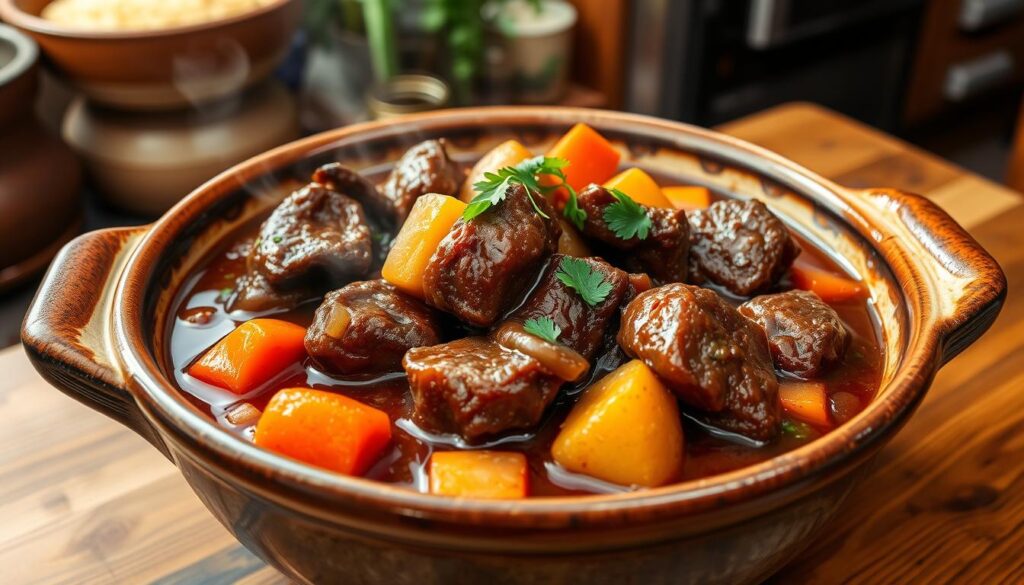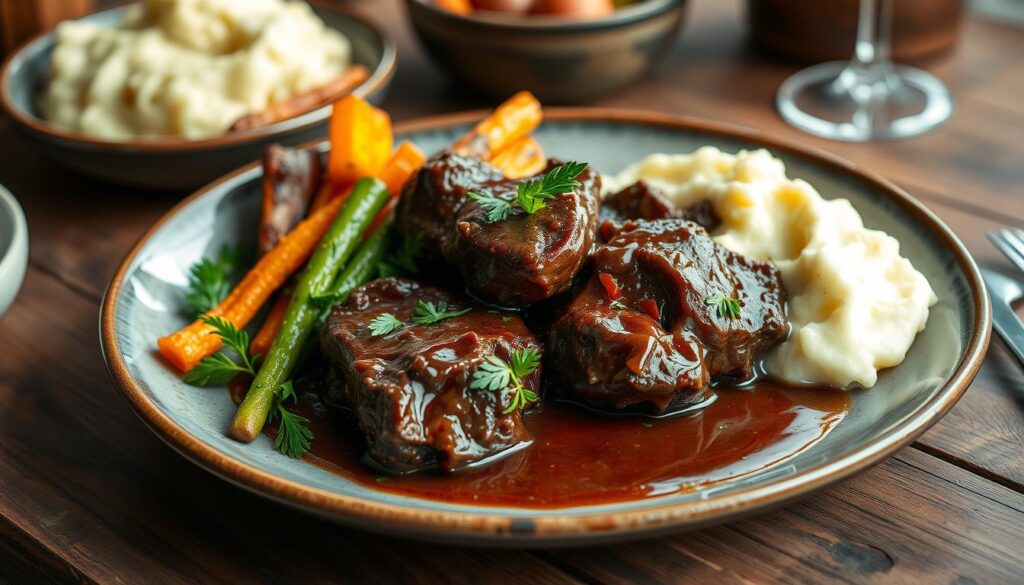Growing up, the smell of a hearty beef stew in our home was unforgettable. It took me to a cozy, comforting place. The meat’s rich, melt-in-your-mouth texture made me eagerly wait for it.
Years later, I found out the secret to this magic: beef cheeks. This unsung hero is about to become your new favorite for soul-warming dishes.
In this article, I’ll share a delicious beef cheeks recipe. It turns this tough meat into a luscious, flavorful delight. Slow-cooked to perfection, these beef cheeks will make you forget about traditional pot roast. Get ready for the ultimate melt-in-your-mouth tenderness and beefy flavor.
Table of Contents
Understanding Beef Cheeks: A Premium Cut of Meat
Beef cheeks, also known as ox cheeks, are a special cut of meat. They come from the cow’s cheek muscles, which are always working. This makes them tough, but they become tender and flavorful when cooked slowly.
What Makes Beef Cheeks Special
Beef cheeks have a unique texture, similar to pulled pork. They also have a rich flavor, like oxtails or a slow-cooked pot roast. This is because of the connective tissue in the muscle, which breaks down during cooking.
Nutritional Benefits of Beef Cheeks
- High in protein, providing essential amino acids
- Good source of iron, zinc, and other essential minerals
- Contains collagen, which can support joint health
- Offers a range of B vitamins, including vitamin B12
Selecting Quality Beef Cheeks
When you’re shopping for beef cheeks, look for fresh, well-trimmed pieces. They should weigh between 8 to 16 ounces raw. The meat should be a deep red color and firm to the touch. Stay away from cheeks that look dry, discolored, or smell bad.
| Characteristic | Ideal Beef Cheeks |
|---|---|
| Color | Deep red |
| Texture | Firm and dense |
| Weight | 8 to 16 ounces raw |
| Appearance | Well-trimmed, no discoloration or off odor |
Essential Ingredients for Perfect Beef Cheeks Recipe
Making a delicious beef cheeks dish needs the right ingredients. At the center are beef cheek stew and beef cheek barbacoa. You’ll also need spices and aromatics to make it taste amazing.
Begin with kosher salt, black pepper, onion powder, and garlic powder. These basics give your dish a savory taste. Add smoked paprika and ground cumin for a smoky and earthy flavor.
Want to try something new? Add chili powder, cayenne pepper, or dried thyme. These spices can make your dish more complex and tailored to your taste.
For a traditional taste, use red wine, onions, carrots, celery, garlic, bay leaf, peppercorns, juniper berries, and rosemary or thyme. These ingredients will make your beef cheek stew or beef cheek barbacoa rich and flavorful, impressing everyone.
| Ingredient | Quantity |
|---|---|
| Beef cheeks | 5 kg |
| Red wine | 75 cl |
| Onions | 2 |
| Carrots | 4 |
| Celery sticks | 4 |
| Garlic cloves | 3 |
| Sea salt | To taste |
| Black peppercorns | To taste |
| Juniper berries | To taste |
| Veal stock | 500 ml |
With these ingredients, you’re set to make a fantastic beef cheek stew or beef cheek barbacoa. It will be a dish that pleases your taste buds and fulfills your cravings.
Preparation Tips and Techniques
Preparing slow-cooked beef cheeks needs careful steps. Start by trimming off any extra fat. But keep some fat for extra flavor and moisture.
For marinating, put the beef cheeks in a big bowl. Pour in half a bottle of red wine. Cover and chill for 12 to 24 hours. This lets the meat soak up the wine’s rich flavors.
Trimming and Cleaning
Before cooking, dry the beef cheeks well with paper towels. This helps them brown and sear properly. A good crust is key for a savory taste.
Marination Process
The marination is crucial for tenderizing the beef cheek ragu. It also adds deep, complex flavors. After marinating, throw away the wine and move on to the next steps.
Seasoning Guidelines
- Mix your favorite spices like salt, black pepper, garlic powder, and more in a small bowl.
- Season each layer of the beef cheeks in the slow cooker. Make sure they’re evenly coated.
- For a classic touch, brown the seasoned beef cheeks in a hot pan or Dutch oven. Then add them to the slow cooker with the rest of the ingredients.
By following these steps, you’ll make a delicious slow-cooked beef cheeks dish. It’s sure to wow your guests.
Slow Cooking Method: The Secret to Tenderness
Beef cheek carnitas and smoked beef cheeks are known for their tender texture. The secret to this tenderness is slow cooking. Whether using a slow cooker or the oven, slow cooking is key to bringing out their full flavor.
For the best results, cook the beef cheeks on the low setting in a slow cooker for 8 hours. No extra liquid is needed, as the meat will release its own juices. This slow process breaks down the meat, making it soft and delicious.
If you prefer the oven, preheat it to 160°C/gas mark 3. Cook the beef cheeks for about 3 hours, turning them every 20-30 minutes. Make sure the liquid level stays below the meat’s level.
Whether using a slow cooker or the oven, slow cooking is essential. The result will be beef cheek carnitas or smoked beef cheeks that are incredibly tender. They will almost melt in your mouth.
| Nutrition Facts | Amount per Serving |
|---|---|
| Calories | 450 kcal |
| Carbohydrates | 10 g |
| Protein | 35 g |
| Fat | 30 g |
| Saturated Fat | 10 g |
| Cholesterol | 100 mg |
| Sodium | 2000 mg |
| Potassium | 700 mg |
| Fiber | 2 g |
| Sugar | 4 g |
| Vitamin A | 1000 IU |
| Vitamin C | 10 mg |
| Calcium | 50 mg |
| Iron | 3 mg |
Remember, the secret to tender beef cheek carnitas or smoked beef cheeks is slow cooking. With patience and attention to detail, you’ll create a dish that will wow everyone.
Wine-Braised Beef Cheeks: Classic Preparation
For a truly delectable beef cheek bourguignon, the secret lies in the wine selection and the art of braising. Beef cheeks are a premium cut, prized for their exceptional tenderness and rich, beefy flavor when cooked low and slow.
Wine Selection Tips
When it comes to braising beef cheeks, choose a full-bodied red wine. A Barolo or Barbera d’Alba works well. These bold, tannic wines complement the robust nature of the beef cheeks, infusing the dish with depth and complexity. About 50cl of red wine is recommended to cover the beef cheeks during the marination process.
Braising Techniques
- Start by browning the beef cheeks in a large, heavy-bottomed pot or Dutch oven to develop a delicious caramelized crust.
- Add a classic mirepoix of chopped celery, carrots, and onions to the pot, along with garlic, tomato concentrate, and balsamic vinegar.
- Deglaze the pan with the red wine, scraping up any flavorful browned bits from the bottom of the pot.
- Pour in beef stock to cover the beef cheeks, then bring the mixture to a boil.
- Cover the pot and transfer it to a preheated oven, where the dish will slowly braise for approximately 4 hours until the beef cheeks are tender and falling apart.
- For the final 2 hours, remove the lid to allow the sauce to reduce and thicken, creating a rich, velvety gravy.
The key to achieving the perfect beef cheek bourguignon is patience and a low, gentle cooking temperature. By embracing the slow braising method, you’ll be rewarded with meltingly tender, flavorful braised beef cheeks that will delight your senses and satisfy your cravings.
Creating the Perfect Sauce and Gravy
To make your beef cheek stew or beef cheek ragu stand out, focus on the sauce. A rich, flavorful sauce can turn your dish into a masterpiece. Start by thickening and seasoning the cooking liquids well.
First, strain the cooking liquid through a fine-mesh sieve. This separates the beef cheeks from the vegetables and herbs. Then, return the liquid to the casserole or slow cooker. Let it simmer over medium heat gently.
This step helps concentrate the flavors and thicken the sauce. For a velvety gravy, mix 1 tablespoon of cornstarch with 1 tablespoon of cold water. Whisk this slurry into the simmering liquid. Cook for 30 minutes more, stirring now and then, until it’s the right consistency. If you want it thicker, use more cornstarch and water.
Now’s the time to add seasonings. A bit of dried thyme, smoked paprika, or Worcestershire sauce can enhance your dish. Taste and adjust the seasoning to get the perfect balance of flavors.
| Ingredient | Quantity |
|---|---|
| Cornstarch | 1-2 tablespoons |
| Cold water | 1-2 tablespoons |
| Dried thyme (optional) | 1 teaspoon |
| Smoked paprika (optional) | 1/2 teaspoon |
| Worcestershire sauce (optional) | 1-2 tablespoons |

Best Side Dish Pairings for Beef Cheeks
When serving beef cheek dishes, the right side dishes can make the meal even better. There are many options that go well with the rich flavors of beef cheeks. These can range from classic choices to newer ideas.
Traditional Accompaniments
Classic sides for beef cheeks include mashed potatoes, creamy polenta, or boiled new potatoes. These options are comforting and soak up the flavorful sauces well.
For a low-carb choice, try beef cheeks with mashed cauliflower or cauliflower rice. The cauliflower’s mild taste lets the beef stand out, and its creamy texture is a nice contrast.
Modern Serving Suggestions
To balance the richness of beef cheeks, pair them with fresh veggies. Honey-glazed carrots, caramelized shallots, roasted asparagus, or steamed broccoli are great choices.
For a lighter option, serve beef cheeks with a simple salad. An arugula salad or a cucumber tomato salad adds a refreshing touch. The acidity and crunch of the greens and veggies balance the beef’s fattiness.
Whether you choose traditional starches or modern veggies, the goal is to enhance the beef cheeks’ flavors and textures. With the right sides, you can make a delicious and balanced beef cheek dish.
Storage and Reheating Guidelines
Slow-cooked or braised beef cheeks can be enjoyed for days. Proper storage and reheating keep these tender morsels delicious.
Leftover beef cheeks can be stored in an airtight container in the fridge for up to 4 days. To reheat, cover the container and microwave at 50% power, stirring often. You can also shred the meat for salads, sandwiches, or wraps.
For longer storage, freeze the cooked beef cheeks. Put the meat in an airtight container or freezer-safe bag, removing air. They can stay frozen for up to 3 months. Thaw in the fridge overnight, then reheat with broth or water to keep it moist.
- Store leftover beef cheeks in an airtight container in the refrigerator for up to 4 days.
- Reheat refrigerated beef cheeks in the microwave at 50% power, stirring occasionally, until heated through.
- For longer storage, freeze cooked beef cheeks in an airtight container or freezer-safe bag for up to 3 months.
- Thaw frozen beef cheeks in the refrigerator overnight before reheating on the stovetop or in the microwave, adding a bit of broth or water to prevent drying.
Follow these simple steps to keep your slow-cooked or braised beef cheeks tasty and tender. Enjoy the rich flavors of this premium cut of meat for days.

Common Mistakes to Avoid
To get the perfect beef cheek bourguignon or smoked beef cheeks, you need to pay close attention. Avoiding common mistakes is key to keeping the meat tender and flavorful.
Temperature Control Tips
One big mistake is cooking beef cheeks at high temperatures. Don’t roast or sear them at extreme heat. This makes the meat tough and leathery.
Instead, cook them at a low, steady temperature. Aim for 225-250°F (107-121°C) for the best results.
Timing Considerations
Beef cheeks need time to cook slowly. This breaks down the tough parts, making the meat tender. Give them 4-5 hours to simmer and get fully flavored.
If the liquid gets too low, add more stock or water. Keeping the right amount of liquid is crucial for a rich, balanced dish.
Recipe Variations and International Styles
Explore a world of flavors with beef cheek dishes. Try different spice mixes for international tastes. For a Mexican flavor, make beef cheek tacos, beef cheek barbacoa, or beef cheek carnitas. Add cumin, chili powder, and cilantro for a bold taste.
Want to try Italian? Turn beef cheeks into a beef cheek ragu for pasta. The meat’s slow cooking makes the sauce rich and smooth. For a French dish, make beef cheek bourguignon with red wine and herbs.
| Cuisine | Dish | Key Ingredients | Cooking Time |
|---|---|---|---|
| Italian | Beef Cheek Ragu | Beef cheeks, red wine, tomato passata, vegetable stock, soffritto (onion, celery, carrot) | At least 2 hours |
| French | Beef Cheek Bourguignon | Beef cheeks, red wine, pearl onions, thyme, bay leaves | 3-4 hours |
| Indian | Beef Cheek Masala Kheema | Beef cheeks, onion, garlic, ginger, spices (cumin, coriander, chili powder) | 1-2 hours |
| Mexican | Beef Cheek Barbacoa | Beef cheeks, dried chiles, canela, allspice, clove | 3-4 hours |
Let the beef cheeks’ natural flavors be the star. Adjust seasonings and ingredients for each culture. Your dishes will be both tasty and educational.
Conclusion
Beef cheeks, when cooked right, are tender and full of flavor. The secret is slow cooking and the right seasonings. Whether it’s braised in wine or slow-cooked with spices, beef cheeks make a great main dish. With patience and the right techniques, you can make a dish that’s as good as pot roast.
This special cut of meat is from the cow’s face. It has fewer calories and fat, but more protein than regular steaks and roasts. Slow cooking makes the meat soft and full of beefy taste.
Choosing a classic tender beef cheeks recipe or trying something new, the goal is to cook it perfectly. With the right methods, you can make this special cut into a memorable meal. Your guests will love it.

